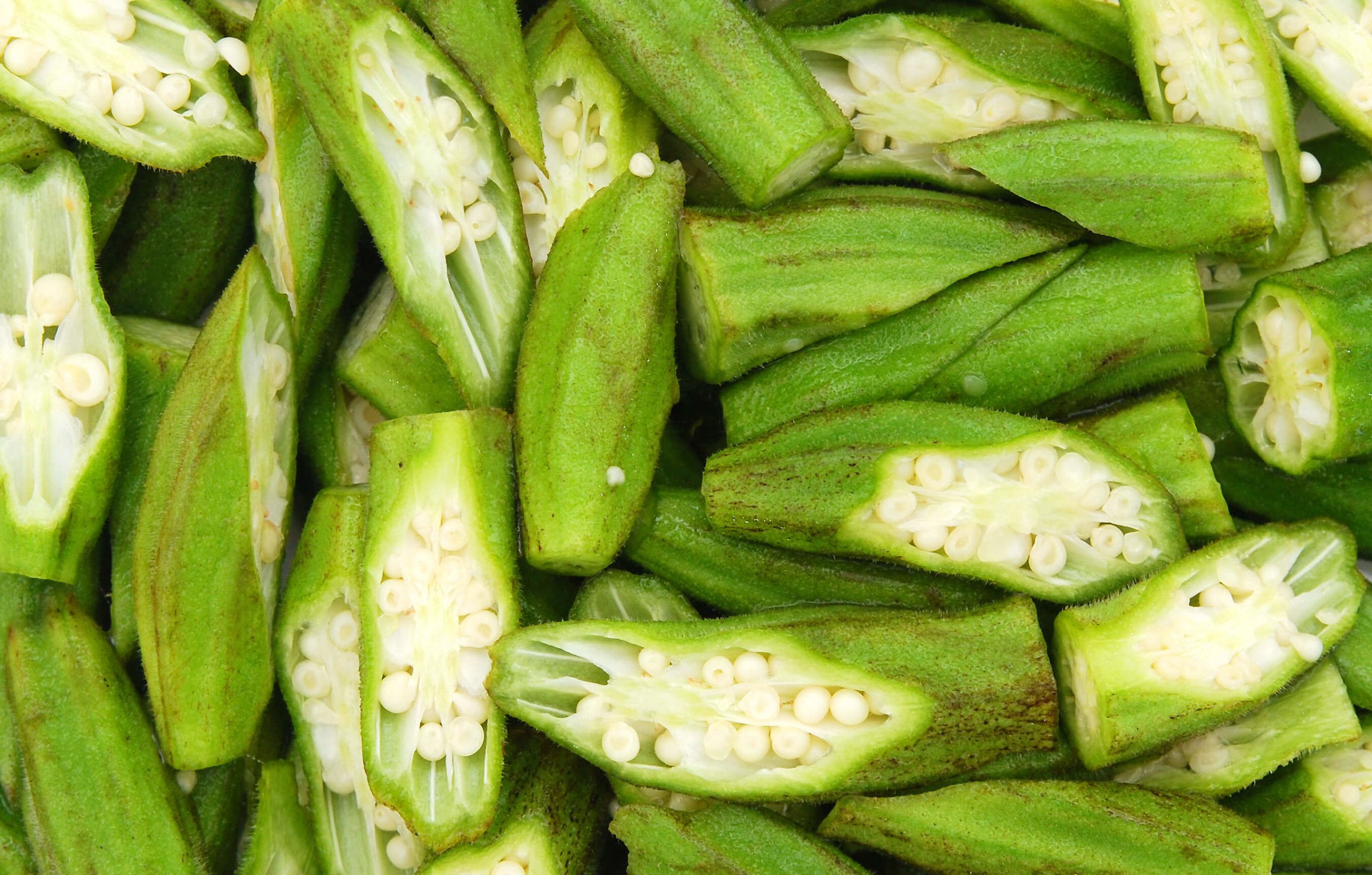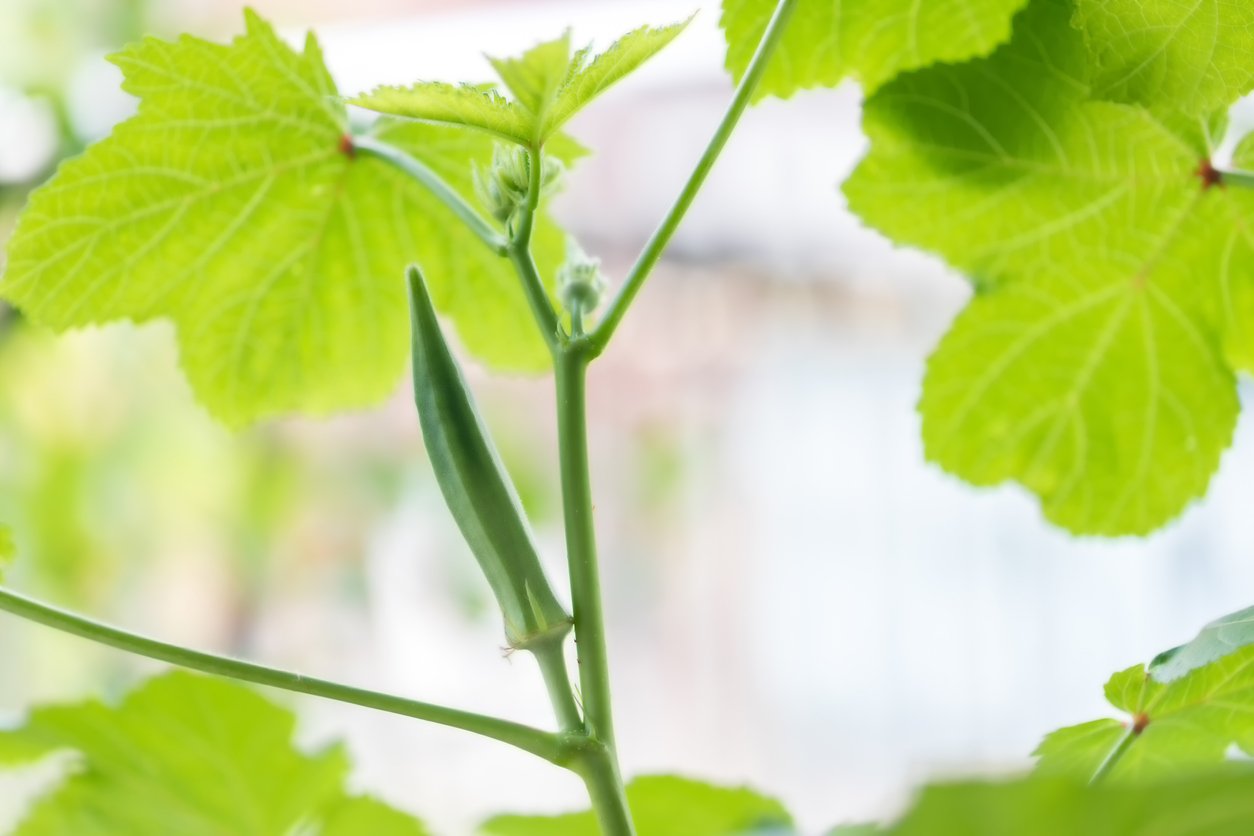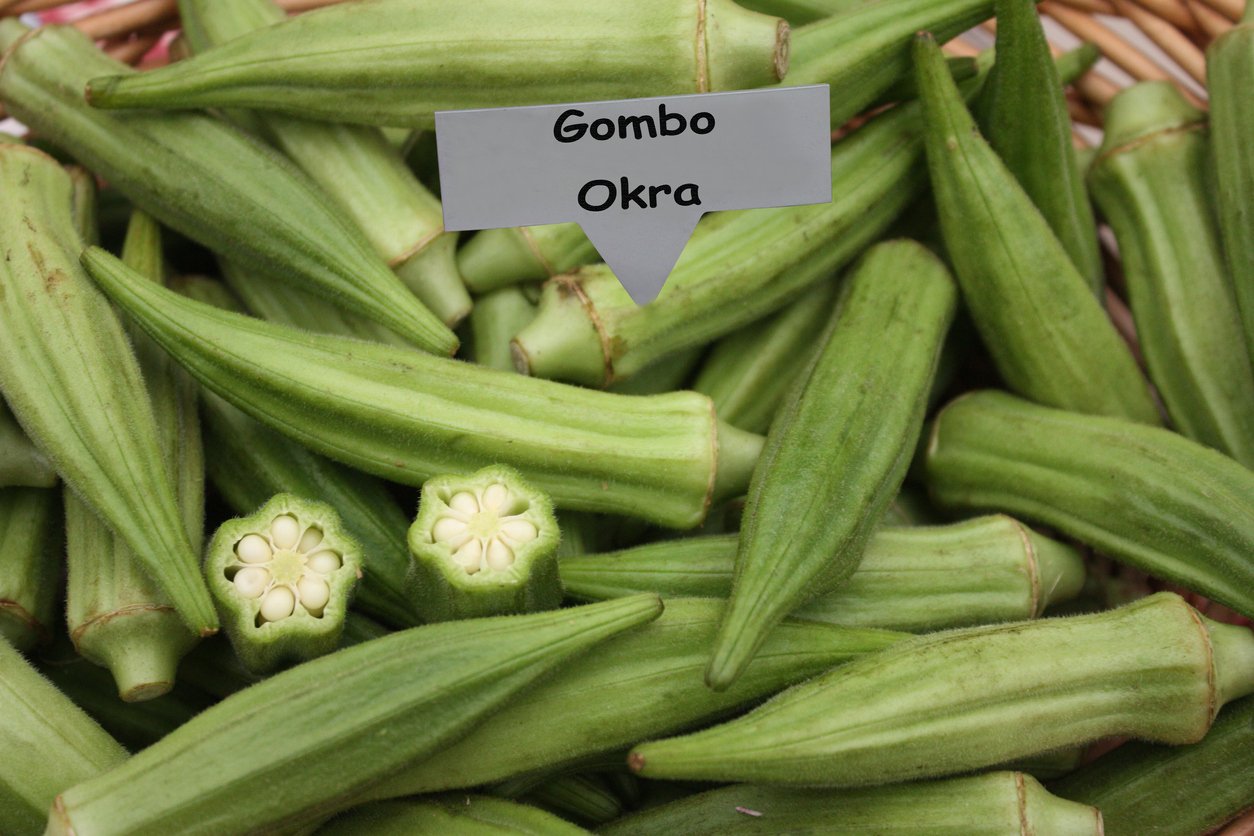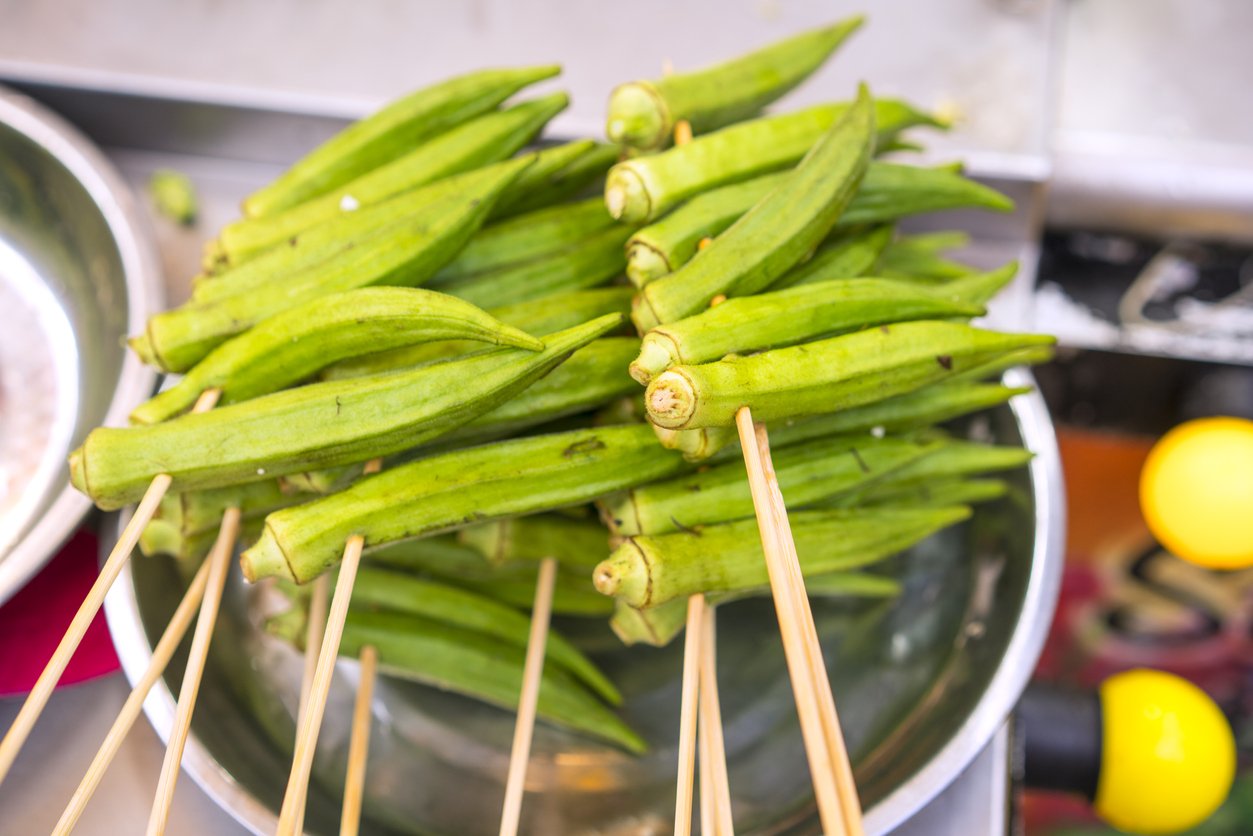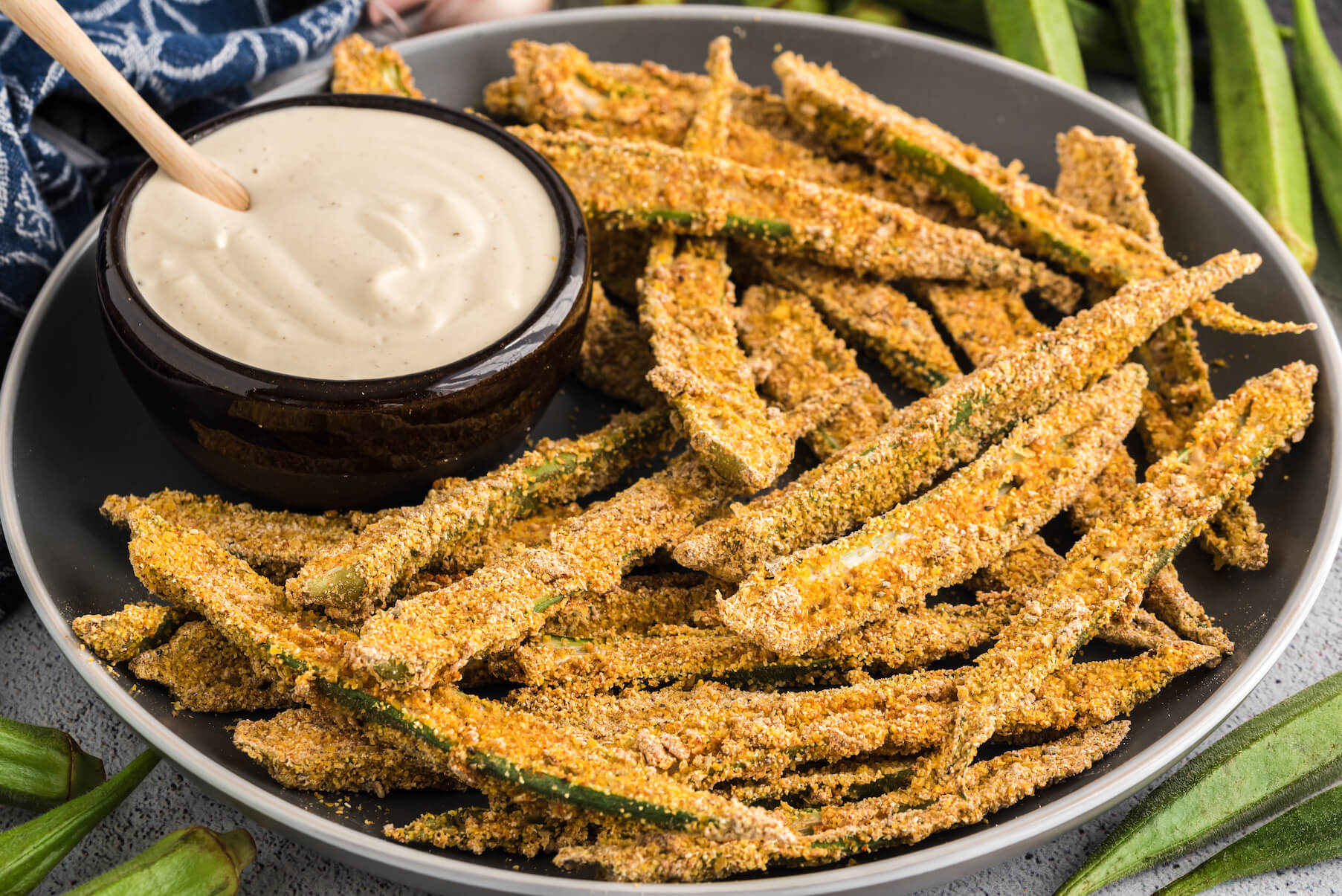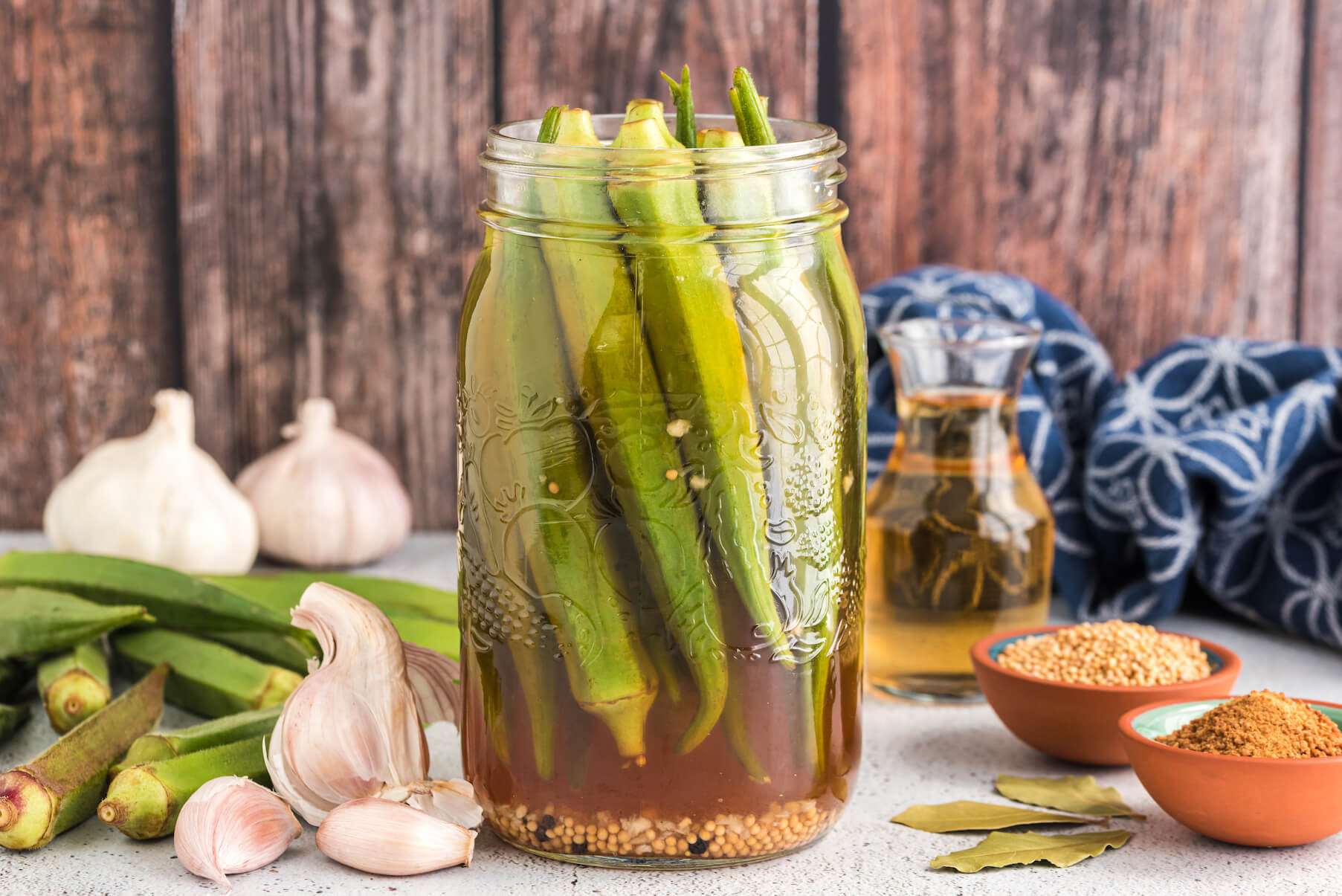If you’ve ever grown okra, you’ll notice something unusual about the plant — it’s got some of the deepest and most tenacious roots of any garden annual. Removing old plants after harvest season is some of the toughest work a grower can do.
And that’s a good metaphor for okra’s complex culinary and cultural history. Rooted in Africa, okra traveled to the Americas and the Caribbean with the slave trade, its seeds literally woven into the hair of captive African women and girls. Once in the US South, the plant thrived in its fertile soils and long hot summers, even as many of the humans who cultivated and subsisted on it were forced to endure the brutalities of slavery. Today, okra is a staple of US Southern cuisine, where it is often served pickled, stewed with tomatoes, grilled, roasted, and — most commonly — mixed with celery, bell peppers, and onions in bowls of gumbo.
Okra grows eagerly in tropical and subtropical climates and offers many nutritional benefits. Despite these wonderful traits, okra isn’t universally appreciated, largely because of its unusual interior texture, which is sometimes described as sticky or slimy (especially when cooked). Some people are unfamiliar with it, don’t find it appetizing, or haven’t gotten the hang of cooking it in a way that works for them.
And some health-conscious plant-eaters may avoid okra because they associate it with deep frying, either solo or in hush puppies, or with animal products such as sausage gumbo.
Yet okra has a lot of potential, in terms of nutrition, health, culinary pleasure — and even environmental healing. In this article, we’ll explore what okra has to offer.
What Is Okra?
Okra (Abelmoschus esculentus) is a six-foot-tall annual herb in the mallow family. Its relatives include such diverse cousins as cotton, hibiscus, and hollyhock. The okra you see in the grocery store or at the farm stand is the seed pod, which can grow up to a foot long once mature.
Okra is picked and eaten, though, when the pods are still unripe and tender, and typically between three and six inches long. (Any longer and they get very fibrous, and not even lots of cooking can soften them up.) Okra has a unique texture and slightly sweet flavor.
The big thing about okra pods is that they exude a mucilaginous juice (some say slime) once cut. Some folks are really turned off by this texture, and as a result, miss out on lots of okra goodness. (Spoiler alert — later in this article you’ll see how to prepare okra in a totally slime-free manner.) But it’s partly due to its mucilaginosity (sorry, spell checker, I like the word, and I’m sticking with it) that okra has become such a key part of many cuisines in the US South — the juice helps cooks out by thickening stews, such as gumbos, inexpensively and deliciously.
If you’ve never tried it, I can try to explain what okra tastes like by saying it’s a cross between asparagus and eggplant, but that totally doesn’t do it justice. So I hope this article will convince you to give it a try, so you can come up with your own description.
We’re not sure who first cultivated okra — Southeast Asia, India, and Africa are all contenders, as each region has a long culinary history with the pod. One likely theory posits that okra originated from the Abyssinian area that now includes Ethiopia, a portion of Eritrea, and the eastern, higher part of the Anglo-Egyptian Sudan. From there, okra may have spread first into Egypt, and then Arabia, North Africa, the Mediterranean, and eastward.
Cultural Importance of Okra
Okra arouses strong feelings, and not just because of its texture. Its history in the Western hemisphere is a story replete with love and hope, cruelty and suffering, oppression and self-determination. Long before it found its way to the Americas and the Caribbean via the slave trade, okra was (and still is) a staple food in many African cultures. In fact, the word “okra” comes from “nkuruma,” the name of the vegetable in the Twi language spoken in a region of West Africa that is now known as the Republic of Ghana.
The word “gumbo,” which originally was a synonym for okra but later referred to any dish in which okra appeared, derives directly from the Angolan word for okra, “ngombo.” Oral history accounts tell of enslaved African women bringing a number of important seeds to the Americas — including not just okra, but also rice and other vegetables and grains — by hiding them in their braided hair. To see how this might have been accomplished, check out this video of Maroon women in the Republic of Suriname demonstrating a hair braiding technique passed down from their ancestors to hide seeds:
View this post on Instagram
Okra, which had been an essential crop in Africa, thrived in the Southern US and helped enslaved Africans survive in a new land. They were sometimes responsible for growing their own subsistence rations, in addition to working for plantation owners. Crops like okra became staple foods for enslaved peoples. Okra, in particular, grew extremely well throughout the long, hot, Southern summers and eventually became a staple in Southern American cooking.
In addition to its African culinary roots, okra is also embedded in Southeast Asian and Indian culinary traditions. The okra pod is known as “lady finger” across some Asian and European countries, “bhindi” on the Indian subcontinent, and “bamia” in the Middle East.
Okra Nutrition Facts
Okra has been valued as a staple despite not being a high source of energy — a pound of cooked okra provides only 100 calories. In other words, if you were going to live on okra, you’d pretty much have to make eating okra your full-time job. But while it’s low in calories, okra shines by providing many important nutrients. It’s a good source of fiber as well as multiple vitamins and minerals, especially vitamin C, vitamin K1, and folate.
Okra fruits contain phenolic compounds, which are powerful antioxidants that combat oxidative stress in the body. Okra seeds, in particular, are antioxidant treasure troves. Compared to okra skins and flesh, the seeds have 10 times higher concentrations of one type of phenolic compound, flavonols, and almost 15 times higher of another, catechins.
In 100 grams of cooked okra (which is about 1 cup), you’ll find the following nutrients:
- Calories 22 kcal
- Protein 1.87 g
- Carbohydrates 4.51 g
- Fiber 2.5 g
- Calcium 77 mg
- Magnesium 36 mg
- Phosphorus 32 mg
- Potassium 135 mg
- Vitamin C 16.3 mg
- Folate 46 mcg
- Vitamin A 14 mcg
- Vitamin K 40 mcg
Health Benefits of Okra
As the proud provider of so many vitamins, minerals, fiber, and other phytonutrients, okra’s unique biochemical profile makes it particularly relevant to a number of specific conditions.
Okra for Gut Health
If you were busy in the fall of 2015, you might have missed the riveting study in the journal Molecules titled, “Acetylated Rhamnogalacturonans from Immature Fruits of Abelmoschus esculentus Inhibit the Adhesion of Helicobacter pylori to Human Gastric Cells by Interaction with Outer Membrane Proteins.” On the off chance that you missed it, let me fill you in.
Helicobacter pylori (H. pylori) is a bacterium that can infect your stomach and damage the tissues in your digestive tract, as well as cause inflammation and painful sores known as peptic ulcers. German and Indian researchers isolated compounds from okra and pitted them against the H. pylori in a test tube that also contained human stomach cells. While the okra compounds didn’t kill or harm the bacteria, they did prevent them from sticking. In theory, this can prevent H. pylori from causing damage even if someone is infected.
What’s more, some health researchers believe that the sliminess of okra, known as mucilage, could be helpful in the treatment of the condition known as leaky gut.
And a study completed in 2020 found that powdered okra fruit helped obese mice maintain healthy blood sugar levels, body weight, and liver composition. The powder appeared to achieve its effects by increasing the ratio of “good” to “bad” bacteria in the mice’s microbiomes. (Lest you get all warm and fuzzy at the idea of researchers seeking to alleviate the health problems of mice, I need to point out that the researchers were the ones who made the mice fat in the first place. Our view on the use of animals in medical research is here.)
Okra for Diabetes
The ability of okra to regulate blood sugar that we saw in that mouse study also makes it a useful plant food in the management of all forms of diabetes. Like other plants in the mallow family (no, that doesn’t include s’mores), okra appears to improve cells’ ability to absorb insulin. Unfortunately, most of the evidence comes from trials conducted on diabetic rats. For some reason, okra has not been extensively studied for its effects on human health. This is unfortunate since as a prolific tropical and subtropical plant, okra could be an inexpensive and widely accessible part of diabetes treatment.
Okra Can Help Fight Malnutrition
In that vein, okra may also be a potent ally in the effort to eradicate malnutrition globally. Specifically, okra plants accumulate several minerals critical to human health and store them in their seed pods. These include calcium, zinc, iron, potassium, phosphorus, and sodium.
If you’ve ever grown okra, its ability to bioaccumulate minerals from the soil will make sense — the plants’ roots are strong, thick, and tenacious (I know more than one person who had to replace their digging fork after attempting to clear the okra bed for fall or winter planting).
Real-world efforts show that okra’s promise to provide minerals to undernourished populations is no myth. Okra grown in kitchen gardens in Ethiopia and Uganda improved the health of the most vulnerable residents of refugee camps, including young children and pregnant and lactating women. Indeed, some cultures in Indonesia and Southeast Asia have encouraged pregnant women to eat okra or even drink okra water — its high folate content might explain why. (And there’s a tradition that consuming okra may lead to pregnancy by acting as an aphrodisiac — I couldn’t find any scientific evidence for this, so here’s a case where you might want to do your own experimentation.)
Okra May Help with Pain Relief
A very cruel-sounding 2013 study found that mice who received powdered okra extract exhibited reduced responses when subjected to various forms of pain, leading the researchers to assume that the powdered okra had an analgesic (pain-relieving) effect.
In 2020, an international team of food scientists assessed the chemical makeup and nutritional profile of Tunisian okra pods. They found several potential analgesic compounds among the dozens of phytonutrients. And for good (or bad) measure, they repeated the mouse experiments and reproduced the results of the 2013 study. The mice who consumed okra appeared to weather the pain inflicted by the researchers with less distress than those given a placebo.
Okra May Help Cognitive Performance
Okra may also enhance cognitive performance, or at least mitigate cognitive impairment. A 2014 study found that okra seed extracts improved the performance and reduced the stress of cognitively impaired mice on various tasks, including mazes and forced swims.
And a 2021 study found that okra can raise levels of brain-derived neurotrophic factor, a protein related to the brain’s ability to learn new information, in mice with Alzheimer’s disease.
(My hope is that researchers can drop the animal experiments and focus on the effects of dietary excellence in people, since giving humans okra seems a lot kinder and also more relevant to humans than inflicting pain or forced swims on mice.)
Environmental Impacts of Okra
With okra, there’s both good and bad environmental news. On the plus side, it turns out that some of the carbohydrates in okra, when combined with fenugreek and tamarind, can remove microplastics from water.
This is a big deal. Microplastics are ubiquitous in our oceans, and end up in the tissues of fish. In 2019, the World Wildlife Federation estimated that the average person consumes around five grams of microplastic every week, with potentially devastating health effects, including endocrine disruption. And the microplastic-removing chemicals commonly used in water treatment facilities can themselves be toxic to humans, so these plant-powered polymers of polysaccharides (how’s that for putting p’s into production?) are welcome news.
On the other hand, conventionally grown okra can come with a large side of organophosphate pesticides. These chemicals are potential neurotoxins and have been found to cause cancer in both humans and animals. Indian researchers found over 18 kinds of organophosphates on okra sold in markets in the city of Hyderabad.
In addition to the organophosphate pesticides, conventional okra production relies heavily on the pesticides belonging to organochlorine, carbamate, pyrethroid, and neonicotinoid groups. Neonicotinoids may be harmful to bees and other pollinators, which is why the European Union has banned several of them.
The answer to avoiding pesticides is pretty simple — we can grow okra organically. And it’s fairly easy to do because the plant is resistant to most pests and diseases. Stink bugs and beetles can colonize the plants and chew up their leaves, but in small-scale growing operations such as home gardens and small farms, these are relatively easy to pick off by hand. So look for organic okra, or okra grown using integrated pest management protocols, or better still, if you live in a warm enough climate, grow your own!
Okra Side Effects
While okra is a nutritional powerhouse, some people should limit their consumption, or avoid it outright. Those with sensitivity to the salicylates or FODMAPs in okra may experience gastrointestinal symptoms upon eating it. Also, the saponins in okra (and other foods, including quinoa) are typically poorly absorbed and may cause irritation or other gastrointestinal symptoms in some people. Fortunately, soaking raw okra pods and cooking them (in the plant science community, these techniques are referred to as “standard processing methods” — gotta love some good jargon!) can mitigate these effects. Just like with quinoa — it’s best to soak okra first and rinse it well before cooking.
Okra is also known to interact with a couple of very common medications — the diabetes drug metformin, and the anti-clotting compound warfarin (due to okra’s high vitamin K content). So check with your health care professional if you’re taking either of those drugs before adding okra to your diet.
Finally, let’s talk about allergies. While the World Health Organization hasn’t found any research showing that eating okra can produce full-blown allergic reactions, there is some evidence that workers who pack or process okra may experience immediate hypersensitivity, or type I, allergic reactions. These immunoglobulin-mediated reactions, which trigger histamine production in response to exposure to the allergen, have only been documented in Nigeria.
Where to Buy & How to Choose Okra
When shopping for okra, look for bright green pods with no discoloration, scarring, or shriveled ends. A good length for an okra pod is 2–4 inches, although the main thing is that the fresh pod isn’t woody. You should be able to snap it in half or cut it easily with a sharp knife. If you find yourself reaching for a chainsaw, you are dealing with a post-consumption pod. Some farmers sell “baby okra,” which are simply smaller and less mature pods.
You can also find presliced, frozen okra, as well as commercially prepared canned or jarred pickled okra. Glass jars are preferable because the cans may contain BPA in the lining, but check the ingredients if you’re trying to avoid preservatives, excess sodium, or added sugar.
In terms of availability, you can generally find frozen, canned, or pickled okra in most grocery stores and supermarkets. Some will offer fresh pods in the produce section — this is common in regional stores and markets that serve Southern US states.
If you live in an okra-growing region, you are likely to find fresh okra at farmers markets from midsummer through fall, when it’s in season. And you can also procure fresh okra at international markets and grocery stores, especially South Asian or Indian markets.
How to Cook Okra & Use it in Recipes
The key thing when cooking okra is, for most people, to neutralize the sliminess while highlighting its uniquely pleasant flavor. One method involves roasting or baking whole pods. Depending on your oven, 10–15 minutes at 425° F (220° C), with or without oil, should cook okra thoroughly and do the trick.
If you have an air fryer, it was pretty much made for preparing yummy okra. See Nichole’s recipe below.
Other methods include sautéing, boiling, and grilling. (Follow the links for instructions and recipes.) To ensure that your sautéed or boiled okra is slime-free, let the pods soak with salt and an acid like vinegar or lemon juice, or cook them in tomato sauce. Soaking isn’t necessary for air frying, grilling, or roasting/baking because the slime dries out in the heat.
Of course, you can make the sliminess your friend by using okra to thicken soups, stews, and gumbos as well as sauces. Okra shines in curries and other fragrant Indian dishes and can make an elegant appetizer or side dish. You can also preserve a large harvest (which you’ll get if you grow your own) by pickling or canning the pods.
Okra also adds pizzazz to salads, like this Japanese-style one, and stir-fries.
Here are some recipes to help you build your okra momentum.
Okra Recipes
Are you ready to give okra a try? Crispy Okra Fries with Garlic Cashew Cream are a crunchy, dippable, and craveable delight that makes okra a shining star. Red Bean Gumbo with Okra is a traditional and savory stew that is satisfyingly delicious and makes okra both appetizing (trust us, you’ll understand once you try it) and also exciting! And if you’re ready to take on the title of okra connoisseur, then Pickled Okra is a deliciously tangy way to enjoy okra. You’ll be surprised to find it’s bursting with lots of flavor, texture, and crunch — it may become your new favorite way to snack on vegetables throughout the day.
1. Crispy Okra Fries with Garlic Cashew Cream
These undeniably delicious fries and dipping sauce come together in just minutes to make the perfect snack or side dish for any of your favorite plant-based sandwich recipes. Crunchy, dippable, craveable, and incredibly delightful, you’ll wonder why you hadn’t tried okra this way before. Its versatility, flavor, and nutrient profile — boasting high calcium, zinc, iron, potassium, and phosphorus — make it a veggie deserving its time in the spotlight. We hope once you give it a try, you’ll love it as much as we do.
2. Red Bean Gumbo with Okra
As we have learned, okra can be a polarizing vegetable, but if you’re on team “no okra, please,” you might want to reconsider — starting with this dish. Okra is rich in magnesium, folate, vitamin C, vitamin K, fiber, and more! Add stewed red kidney beans, savory herbs and spices, and whole grains to it and you have a bountiful, nourishing, and tasty dish that will be hard not to love.
3. Pickled Okra
Pickling vegetables is a culinary tradition, not only as a means of preservation but also as a way to add briny and acidic pungency to dishes. You might wonder how to use this seed pod in pickled form — do you eat it on its own, top it on a salad, or add it to a soup or stew? The answer to all of the above is yes! Pickled okra is a deliciously tangy way to enjoy the veggie — it’s bursting with flavor, texture, and crunch, and best of all, none of the slime. Try it on any savory dish that needs a little extra tang and nutrition.
Okra IS Good for You!
Okra is a controversial food due to its tendency to be slimy when cut, and because of its complicated history and the tragic context of its journey to the Americas and Caribbean. If you didn’t grow up eating it, you may think of okra as exotic and it may feel at first like an acquired taste. But for many people around the world, okra is a beloved vegetable of great culinary value and deep historical roots.
And whether you know okra well or are just learning about it, the fact remains that it is a highly nutritious vegetable with multiple health benefits and few potential downsides. Raw, cooked, or pickled, okra deserves your attention, and — I predict — your appreciation as well.
Tell us in the comments:
- Have you tried okra? What was your first impression?
- If you have a cultural tradition of cooking with okra, what’s your favorite way to enjoy it?
- What plant-based okra recipe will you try?
Feature Image: iStock.com/HONG VO
